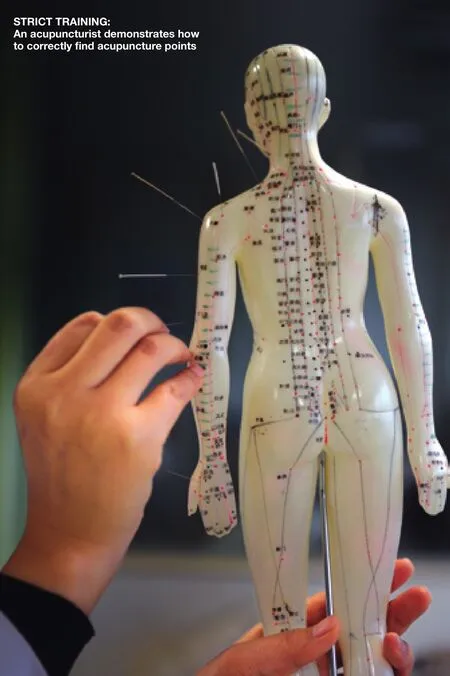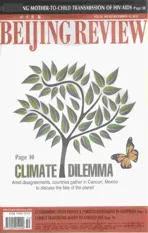Magic Needles
2010-10-14ByYULINTAO
By YU LINTAO
Magic Needles
By YU LINTAO
Acupuncture and moxibustion inscribed on UNESCO’s list of intangible cultural heritage

CFP
On November 16, UNESCO officially approved the inclusion of acupuncture and moxibustion, a traditional Chinese medicine therapy, on its Representative List of the Intangible Cultural Heritage of Humanity. The number of Chinese cultural items on the list now totals 28, greater than any other country in the world.
“The listing of acupuncture and moxibustion as intangible cultural heritage has con fi rmed China’s position as the country of origin of these skills and laid a good foundation for the internationalization of traditional Chinese medicine,” said Huang Jianyin, Deputy Secretary General of the World Federation of Chinese Medicine Societies. Huang has previously expressed worries about acupuncture and moxibustion declining.
Yang Jinsheng, Deputy Director of the Institute of Acupuncture and Moxibustion under China Academy of Chinese Medical Sciences, said inscribing will restore the original characteristics of acupuncture and moxibustion and contribute to sound development. “This is an effective way to protect them,” he said.
Ancient and profound
Acupuncture and moxibustion are an important part of traditional Chinese medicine. The seemingly mysterious medical treatment has been widely practiced in China, especially in ancient times. These therapeutic methods date back at least 2,000 years. The acupuncture and moxibustion are based on the theory that the human body acts as a small universe connected by channels. Through physical stimulation of these channels, the human body’s self-regulating function can be promoted and health achieved.
Acupuncture itself involves inserting and manipulating needles in various acupuncture points in the body to clear and connect the channels so as to relieve pain or for therapeutic purposes. Research shows acupuncture points are related to the nervous system, blood and lymph vessels as well as muscles. In the Chinese medicine, there are more than 400 acupuncture points spread all over the human body.
Acupuncture needles are usually made of silver or stainless steel. Moxibustion treats disease through warming an acupuncture point on the body surface by the burning of a combination of herbs, primarily mugwort.
Acupuncture and moxibustion are relatively easy to operate and the cost is reasonable. In most cases, no side effects occur at all during the treatment. At the same time, it can operate in unison with other treatments.
Around 300 kinds of diseases can be treated by acupuncture and moxibustion. The therapy has obvious curative effects for more than 100 diseases, such as neuritis, neuralgia,certain types of pain, headaches and disturbance in intestinal function. The ef fi cacy of the therapy in the treatment of facial paralysis and apoplectic sequelae is most widely known.
As early as the 1980s, the World Health Organization (WHO) had con fi rmed acupuncture and moxibustion were very effective in the treatment of 43 diseases, including neurologic gastrointestinal system, dental and respiratory system diseases. The National Health Service of Britain has even said there is reasonably good evidence acupuncture is an effective treatment for nausea, vomiting, osteoarthritis of the knee and several types of pain.
Protection and inheritance
Though with such a long history and now applied in more than 150 countries and regions, traditional Chinese medicine is declining in China nowadays.
“Acupuncture and moxibustion have a very wide application range. But, the therapies have caught up with the pace of the development of modern medicine and lack evidence-based theory to support them.This eventually meant this treatment approach became only a recovery method,severely limiting its efficacy,” said Shen Weidong, Director of the Acupuncture and Moxibustion Department of Shuguang Hospital in Shanghai.
Besides, treatment charges for Chinese medicine are much lower than for Western medicine, which has led to many Chinese medicine hospitals and practitioners turning to the Western variety. Consequently,acupuncture and moxibustion have not been fully able to show their real value.
On November 24, at the press conference about the successful application for inscription on the UNESCO list, Wang Guoqiang,Vice Minister of Chinese Ministry of Health,said the State Administration of Traditional Chinese Medicine would work out a practical plan to protect and develop the traditional therapies. It is also planning to explore effective ways of passing on the techniques,identifying skilled practitioners and setting up a full archive of important medical books.
“Without any doubt, acupuncture and moxibustion becoming an intangible cultural heritage give us a chance to promote the protection, passing on and innovation in Chinese medicine. It will also add weight to Chinese medicine and urge the government to pay more attention to its development. Meanwhile, we should take this opportunity to intensify our efforts to introduce Chinese medicine to the whole world, contributing to the health of mankind,” Wang said.
He also said China would make practical plans for the publicity and protection of Chinese medicine. First, he said, the value of traditional acupuncture and moxibustion needs to be further studied, and then analyzing work should be done to decide what are key aspects to protect.
“We will explore more and effective inheritance models for it on the basis of preserving traditional ways. For instance, setting up a special work studio for acupuncturists could provide better conditions for the heritage and perfect its mechanisms,” he said.

HANDS ON: Chinese and foreign medical students study acupuncture and moxibustion in Shenyang Traditional Chinese Medicine Hospital
Wang also said further work would be scheduled, including building a museum of acupuncture and moxibustion to display related historic relics and materials, and ancient books and records of traditional techniques; compiling, recording and publishing the tales of experienced acupuncturists; and organizing seminars for exchanges of experience and techniques.
Step to the world
One thousand years ago, acupuncture and moxibustion spread from China to surrounding countries such as Korea, Japan,Viet Nam, and elsewhere in East Asia. The treatments were introduced to Europe by Western missionaries but didn’t gain a fl ourishing hold in the West.
Not until 1972 when President Richard Nixon visited China, did acupuncture and moxibustion gain wide attention in the Western world. James Reston, a well-knownNew York Timesreporter who accompanied Nixon during the visit, received acupuncture in China for post-operative pain after undergoing an emergency appendectomy. He was astonished at the miraculous easing brought on by the therapy and reported about it upon returning to the United States.
At present, Chinese medicine has gained wide acceptance in the world. Every year,among foreigners who study natural sciences in China, Chinese medicine and acupuncture majors account for the greatest proportion.Every year Shuguang Hospital enrolls many short-term international training students, 90 percent of whom are there to learn acupuncture, Professor Shen said.
Statistics of the World Federation of Chinese Medicine Societies show currently there are at least 200,000 practicing acupuncturists abroad while the annual output of the industry reaches $10 billion.
In the United States, acupuncture is authorized in every state. There are more than 50 schools teaching acupuncture and moxibustion in the United States. The number of certificated acupuncturists in the United States has passed 14,000.
In European countries such as France,Germany, Spain, Italy and Holland, there is at least one Chinese medicine clinic or acupuncture clinic for every 15,000 citizens.
In Britain, acupuncture and moxibustion schools began to set up during the 1980s.The British Medical Acupuncture Society says the number of people receiving acupuncture and moxibustion treatment has“obviously” increased in recent years. There are several thousand professional acupuncturists in Britain; most of them are British,but a few came from China.
In the process of acupuncture and moxibustion spreading to the world, its standardization is very necessary. Wang said most standards of the therapy came from the practice of Chinese medicine, and China, as well as the WHO, are also making efforts in the standardization work.
